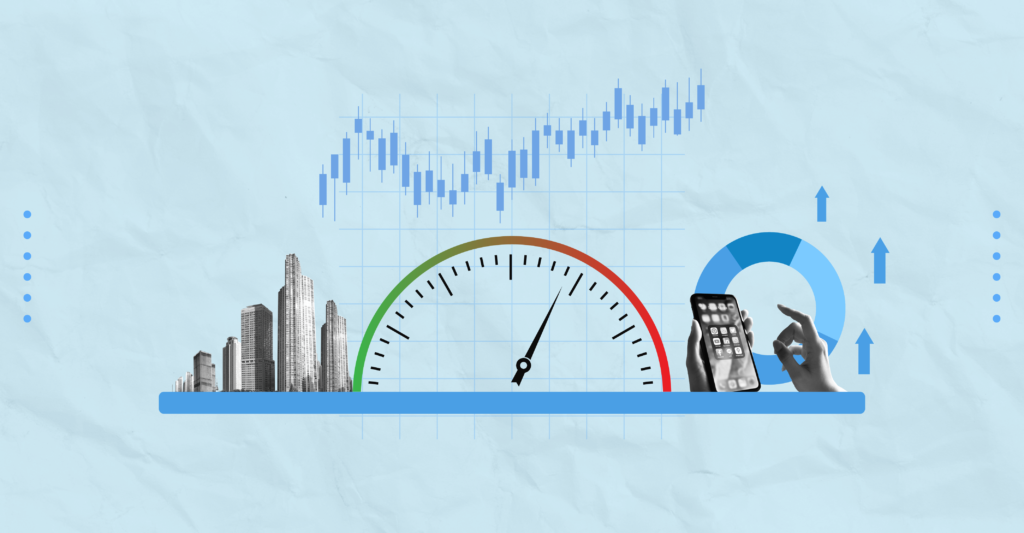Last Updated on Jun 4, 2025 by Aishika Banerjee
Since its inception, the working of the stock market has undergone several changes. And thanks to technology for making it easy for investors. Now an investor can buy or sell any stock from anywhere in the world. And all an investor needs to do is perform thorough research about a particular stock before investing. Though several fundamental and technical factors are considered before investing, market sentiment can also help understand stock and the market. In this article, let’s discuss market sentiment analysis, its importance and how to measure it in detail.
Table of Contents
What is Market Sentiment?
Market sentiment is the attitude and mood of investors towards a stock or a specific sector in the market. In simple terms, market sentiment can be described as the aggregated public view or opinion that can make up market psychology. The public and investor sentiments on the market can result from several external factors like policy changes, management behaviour, natural disasters or any macroeconomic factor. This sentiment can impact the price of stock either positively or negatively.
How can Market Sentiment Impact the Stock Market?
The falling stock prices indicate bear market sentiment, while the rise in the prices indicates bullish market sentiment. Usually, markets are driven by emotions like fear and greed. When there is a stock with certain positive changes to the management or any external factor, everyone wants to buy the stock expecting it would make high returns. This eventually can lead to a bullish trend. And if any negative or unimpressive changes take place in the company, the stock can see a bearish trend. Analysing these emotions in the stock market is called market sentiment analysis.
Importance of Market Sentiment Analysis to Predict a Stock Price
Let’s assume there is a stock where the price increases, and you try to invest in it without analysing the company. This can be due to the fear of missing out (FOMO). In such cases, we might have seen that after investing, the stock prices start coming down, entering the bear market, which can turn out to be a loss for the investor.
For example, you are buying 10 stocks for Rs. 100. But after you buy, the stock price drops. In this case, out of fear, selling all 10 stocks for Rs. 70 is a loss. This is because you didn’t know the right time to invest in the market and got driven by the market movements.
An investor can use market sentiment analysis in finance and market sentiment analysis methods to determine whether the market is driven by feelings and emotions or by rational decision-making. Market sentiment and market mood analysis is considered valuable as it can help you determine the opinion of investors.
How to Measure Market Sentiment?
Though there is no specific way to measure the market sentiment, it can be analysed using certain important indicators, as given below.
VIX
The Volatility Index (VIX) is a fear index. Suppose the traders feel like their investment needs protection against risk; it’s a sign of volatility. An increase in VIX will increase the need for insurance in the market. India VIX is used in NSE. Five variables are used to calculate India VIX – the stock’s market price, strike price, expiry date, risk-free returns, and volatility. The volatility index is between 15 and 35. A value below 15 means low volatility, while more than 35 is high volatility.
High-Low Index
This is a price-strength indicator to measure how strongly the market is moving towards a bullish or a bearish trend. This index is derived by dividing the number of stocks making 52-week high by the total number of stocks. If the index is positive, it is considered a bullish sentiment market. If the index is negative or low, it is considered a bearish sentiment market. It is a simple momentum indicator to determine overbought market conditions.
Market breadth
Market breadth is a technical indicator for market sentiment measurement and the direction of the market. It analyses the number of companies that are advancing compared to the number of companies that are declining. The positive result indicates that the market is in an upward motion. Positive market breadth occurs when more stocks are on the upward path and vice versa. Market breadth is calculated by dividing the Advance Decline (AD) ratio by the Advance Decline volume.
Momentum
Momentum is nothing but a stock price going up its current value. When several companies exhibit momentum, the broader market is considering having momentum. While the positive momentum value is considered a bulls market, the negative value is considered a bear market. Out of several ways, momentum can be calculated by considering the exponential moving averages of Nifty. It is the difference between the 90-day and 30-day exponential moving averages of Nifty, divided by the 90-day moving average. A negative value indicates negative momentum and vice versa.
Foreign Institutional Investors (FII)
FII have a good amount of money invested in the Indian stock market. If they have invested more in the market, it is considered a positive factor for the market. The activities of FII are available on NSE and BSE websites.
Demand for gold
It is calculated by considering the price return of gold for 2 weeks and comparing it with the return on Nifty during the same period. If the demand for gold is high, the demand for equities is declining.
What is the Market Mood Index?
Apart from the above-listed investor sentiment indicators, there are a few other indicators as well to analyse the market sentiment. However, it is not an easy task to calculate each and every indicator, as one or two indicators may not give a clear picture of the market. To make it easy for the investors, on Tickertape, we have the Market Mood Index (MMI), which is nothing but sentiment analysis tools. It considers all the parameters listed above to determine the market mood.
Tickertape’s Market Mood Index represents the market sentiment in four different zones – extreme fear, fear, greed and extreme greed. These zones have certain indexes representing whether the market is overbought or oversold.
Conclusion
Though buying or selling a stock is simple, background research takes a lot of time. And an investor can’t take risks with hard-earned money. Hence it is vital to understand the market movements and the reason behind them. Investing after considering the market’s behaviour and the individual company analysis and sentiment analysis techniques can help gain good returns. Warren Buffett once said, “Risk comes from not knowing what you are doing”, and nothing can explain the importance of investor sentiment analysis before investing better than this.
Frequently Asked Questions About Market Sentiment
1. What is the market sentiment today?
Similar to the stock market, the sentiments also keep changing. You can check the prevalent market sentiment on Tickertape’s Market Mood Index.
2. What is the market mood index in India?
The market mood index indicates the current emotions of the investors or traders towards the stock market. It helps in determining the right time to invest in the market.
3. What are market sentiment indicators in India?
Market sentiments can be analysed using several indicators. Some of the important indicators listed in this article are – VIX, high-low index, market breadth, momentum, FII and demand for gold.
4. Is it important to analyse sentiment in the stock market?
Investment in the stock market is always about the right timing. Buying or selling at the right time can gain you profits. And analysing market sentiment in the stock market will help you understand the market’s mood and whether it is the right time to buy or sell a stock.
- How To Withdraw Mutual Funds? - Jun 6, 2025
- Top Maternity Insurance With Low Waiting Periods - Jun 5, 2025
- ROE vs ROCE – What are the Differences? - Jun 5, 2025





